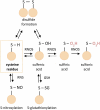Irreversible oxidative post-translational modifications in heart disease
- PMID: 31361162
- PMCID: PMC6816499
- DOI: 10.1080/14789450.2019.1645602
Irreversible oxidative post-translational modifications in heart disease
Abstract
Introduction: Development of specific biomarkers aiding early diagnosis of heart failure is an ongoing challenge. Biomarkers commonly used in clinical routine usually act as readouts of an already existing acute condition rather than disease initiation. Functional decline of cardiac muscle is greatly aggravated by increased oxidative stress and damage of proteins. Oxidative post-translational modifications occur already at early stages of tissue damage and are thus regarded as potential up-coming disease markers. Areas covered: Clinical practice regarding commonly used biomarkers for heart disease is briefly summarized. The types of oxidative post-translational modification in cardiac pathologies are discussed with a special focus on available quantitative techniques and characteristics of individual modifications with regard to their stability and analytical accessibility. As irreversible oxidative modifications trigger protein degradation pathways or cause protein aggregation, both influencing biomarker abundance, a chapter is dedicated to their regulation in the heart.
Keywords: Heart failure; oxidative stress; post-translational modifications; protein aggregation; protein degradation.
Figures





Similar articles
-
Post-translational modifications disclose a dual role for redox stress in cardiovascular pathophysiology.Life Sci. 2015 May 15;129:42-7. doi: 10.1016/j.lfs.2014.11.008. Epub 2014 Nov 27. Life Sci. 2015. PMID: 25433127 Review.
-
Immuno-Spin Trapping-Based Detection of Oxidative Modifications in Cardiomyocytes and Coronary Endothelium in the Progression of Heart Failure in Tgαq*44 Mice.Front Immunol. 2018 May 7;9:938. doi: 10.3389/fimmu.2018.00938. eCollection 2018. Front Immunol. 2018. PMID: 29867936 Free PMC article.
-
Oxidative post-translational modifications develop LONP1 dysfunction in pressure overload heart failure.Circ Heart Fail. 2014 May;7(3):500-9. doi: 10.1161/CIRCHEARTFAILURE.113.001062. Epub 2014 Apr 16. Circ Heart Fail. 2014. PMID: 24740269
-
Protein post-translational modifications and misfolding: new concepts in heart failure.Proteomics Clin Appl. 2014 Aug;8(7-8):534-42. doi: 10.1002/prca.201400037. Proteomics Clin Appl. 2014. PMID: 24946239 Free PMC article. Review.
-
Oxidation of cardiac myofilament proteins: Priming for dysfunction?Mol Aspects Med. 2018 Oct;63:47-58. doi: 10.1016/j.mam.2018.08.003. Epub 2018 Aug 23. Mol Aspects Med. 2018. PMID: 30130564 Review.
Cited by
-
Protein Oxidative Modifications in Neurodegenerative Diseases: From Advances in Detection and Modelling to Their Use as Disease Biomarkers.Antioxidants (Basel). 2024 May 31;13(6):681. doi: 10.3390/antiox13060681. Antioxidants (Basel). 2024. PMID: 38929122 Free PMC article. Review.
-
Proteomics of the heart.Physiol Rev. 2024 Jul 1;104(3):931-982. doi: 10.1152/physrev.00026.2023. Epub 2024 Feb 1. Physiol Rev. 2024. PMID: 38300522 Free PMC article. Review.
-
Bioinformatics tools and data resources for assay development of fluid protein biomarkers.Biomark Res. 2022 Nov 15;10(1):83. doi: 10.1186/s40364-022-00425-w. Biomark Res. 2022. PMID: 36380380 Free PMC article. Review.
-
Novel Oxidative Stress Biomarkers with Risk Prognosis Values in Heart Failure.Biomedicines. 2023 Mar 15;11(3):917. doi: 10.3390/biomedicines11030917. Biomedicines. 2023. PMID: 36979896 Free PMC article. Review.
-
Mechanisms of Oxidative Stress in Metabolic Syndrome.Int J Mol Sci. 2023 Apr 26;24(9):7898. doi: 10.3390/ijms24097898. Int J Mol Sci. 2023. PMID: 37175603 Free PMC article. Review.
References
-
- Mailloux RJ, McBride SL, Harper ME. Unearthing the secrets of mitochondrial ROS and glutathione in bioenergetics. Trends Biochem Sci. 2013;38(12):592–602. - PubMed
Publication types
MeSH terms
Grants and funding
LinkOut - more resources
Full Text Sources
Medical
Research Materials
